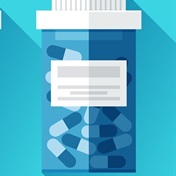
The chances that your doctor will give you antibiotics when you're sick may be influenced by geography, new research reveals.
It's tough to know exactly what factors contributed to the regional variations the research team found in antibiotic prescription rates, said study author Lauri Hicks, medical director of the US Centers for Disease Control and Prevention.
"Why is West Virginia more than double compared to Alaska? I imagine there are provider factors, patient factors and cultural factors that are all shaping the impact," Hicks said.
Antibiotics not a magic bullet
Some patients may pressure physicians to give them what they perceive as a "quick fix" so they can get back to work sooner or return their sick child to day care, Hicks added. Unfortunately, that contributes to the growing problem of antibiotic resistance, she said.
"We should be thinking of antibiotics not as a magic bullet, but as a precious resource that we should only use when absolutely necessary," she said.
The researchers also found that there are higher rates of obesity and smoking in areas where there is more antibiotic use.
The research offers fresh insight into how the way antibiotics are prescribed may be affecting the growing problem of drug resistance.
Here's what the team found:
- In 2010, health care providers prescribed 258 million courses of antibiotics, or 833 prescriptions per 1 000 people, on average.
- Penicillin and a class of antibiotics known as macrolides (including drugs such as azithromycin and erythromycin, for example) were the most commonly prescribed.
- Prescription rates were higher in the South (936 prescriptions per 1 000 people) and lower in the West (639 prescriptions per 1 000 people).
- Prescriptions were more frequently written for children under 10 and adults aged 65 and older.
- Prescribing rates varied considerably by physician specialty.
The trends are troubling, Hicks said, as the war against bacterial infections is getting harder to fight. Increased antibiotic usage is associated with growing resistance to the drugs, she said.
"When people think about antibiotic resistance, they think it's their body being resistant," Hicks said. "They don't realise that the actual number of microbes or bacterial cells in the body outnumber the human [cells]."
The bacteria are changing so rapidly - some replicate every 40 minutes - that they continually evolve, making them better able to resist antibiotics to which they've been exposed, Hicks said.
That leaves an increasing number of people virtually defenceless against infections that once were relatively easy to resolve. And scientists estimate that 50% of prescriptions for antibiotics may be unnecessary.
"There are infections out there that have become almost impossible to treat," Hicks said.
"We really are on the verge of going down a path where there may be nothing that works. Now we're seeing young, healthy people getting these highly resistant infections requiring hospitalisation where in the past a simple oral antibiotic would have taken care of it."
The CDC is trying to help solve the problem of antibiotic drug resistance by increasing public awareness and educating physicians about the most effective way to prescribe antibiotics, said Hicks, who is director of the agency's Get Smart: Know When Antibiotics Work program.
Far from harmless
In the latest research, the scientists tapped into a database that included more than 70% of the nation's prescriptions in 2010. Drawing from prescriptions and census information, they calculated prescribing rates for outpatient oral antibiotics.
"The database is like a [national] census of antibiotic use," and the information was obtained from all pharmacies and drug makers nationwide, Hicks said.
Many people think antibiotics are harmless, but side effects and allergies to the medications are actually one of the most common reasons people go to the emergency room, she said.
"You can get anything ranging from an itchy rash to diarrhoea, a torn Achilles tendon from taking a fluoroquinolone like Bactrim, an anaphylactic reaction (an immune system reaction that causes shock) or toxic epidermal necrolysis (a life-threatening skin condition)," Hicks said.
Dr Len Horovitz, a pulmonologist at Lenox Hill Hospital in New York City, said he sees patients every day who want and expect to get antibiotics.
"Intelligent people have magical thinking: problem, solution, cure," he said. "They don't ride out problems in their professional life, they solve them." This causes them to expect a quick resolution to their pesky cold, sinus and flu symptoms, which are caused by viruses and cannot, therefore, be treated with antibiotics. Only bacterial infections can be effectively treated with antibiotics.
Horovitz said physicians need to practice due diligence and take a culture to assess what bacteria, if any, are present before prescribing an antibiotic.
"They often just bomb with antibiotics," he said.
More information
For more about antibiotic resistance, try the US Centers for Disease Control and Prevention.
(Copyright © 2013 HealthDay. All rights reserved.)




 Publications
Publications
 Partners
Partners















